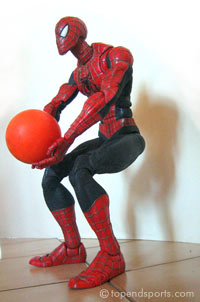Medicine ball throw tests are used for assessing power. The underhand throw for distance is a test of upper and lower body strength and explosive power. There are other Medicine Ball Fitness Tests.
purpose: This test measures upper and lower body strength and explosive power.
equipment required: 2 to 5 kg medicine ball (depending on the age group being tested), tape measure.
pre-test: Explain the test procedures to the subject. Perform screening of health risks and obtain informed consent. Prepare forms and record basic information such as age, height, body weight, gender and test conditions (wind?). Check the weight of the medicine ball. The start line should be clearly marked. Perform a standardized warm-up. See more details of pre-test procedures.
procedure: The subject stands at a line with the feet slightly apart, and facing the direction to which the ball is to be thrown. The ball is held in both hands between the legs, with the arms extended forward and downward. The hands are placed behind and under the ball. Using the legs, back and arms to assist, the ball then thrown vigorously forward as far as possible. The subject is permitted to fall forward over the line after the ball is released, and is in fact encouraged to do so in maximizing the distance of the throw. Three attempts are allowed.

scoring: The distance from the starting position to where the ball lands is recorded. The measurement is recorded to the nearest 0.5 foot or 10 cm. The best result of three throws is used.
target population: sports in which upper body strength is important, such as rowing, tennis, javelin throwing
advantages: this test is easy and quick to perform for an individual.
disadvantages: several people are needed to conduct this test smoothly: one to mark results, another to check technique and another to collect and return the balls. If testing a large group of participants, it can be time consuming to put all of them through this test.
comments: The angle the ball is thrown is important. You may want to explain to the subject about the optimal angle for maximal distance, and to allow some practice attempts. You may aid in the ease of measurement for this test by extending a tape measure out along the expected path in front of the subject. When recording the distance, you can either move the tape to where the ball landed, or less accurately align where the ball landed to the approximate distance on the tape.
variations: A similar technique can be used to throw the medicine ball toss over the head behind the subject. See also other medicine ball throw tests. The weight of the medicine ball will obviously affect results, and should be selected to best test the age group or abilities of your participants.
Similar Tests
- Standing or Side Medicine Ball Throw
- Overhead Powerball Backwards Throw
- Powerball Kneeling Overhead Toss
- Power Clean Max Test
Related Pages
- Medicine Ball Fitness Tests
- About Medicine Balls
- Other speed and power tests
- medicine balls for sale
- why Spider-Man?


 Current Events
Current Events